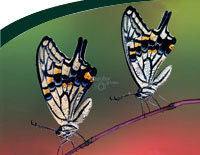


The М. Shcherbak
Zoological
Museum
Exposition Plan of Zoological Museum

1. Diorama «Underwater World» |
9. Diorama «Black Sea Reserve» |
The Zoological Museum is one of the oldest within the complex of the National Museum of Natural History. It was founded in 1919 by Academician Mykola Kashchenko. In 1966 the Museum became a part of the Central Museum of Natural History at the Academy of Sciences of Ukraine. And already in the following year, under the direction of Mykola Shcherbak, the reconstruction of the Museum was fully completed. The Museum opened its doors for visitors.
The Zoological Museum occupies the entire third floor of the Museum complex. The exposition of the Museum is arranged in a long gallery and also in two big halls — one hall displays birds and the other — mammals.
The exposition materials are a mere small portion of the big and unique collections, which are kept in the Museum store rooms. Approximately 5,000 animals of 4,000 species are exhibited today.
The exposition is arranged toxonomically. Its peculiar feature is the landscape dioramas which introduce to the majority of natural zones of the world.
The exposition begins with the invertebrates, the largest group of animals as to the number of taxa. This group includes protozoans, sponges, coelenterates, different types of worms, molluscs, etc. The visitors' attention is caught by the skeletons of glass sponges, as well as a cup-shaped sponge, Poterion neptuni, which really resembles an enormous goblet.
Further on, the visitors can familiarize themselves with a diverse world of corals with skeletons varying in form and color — white, blue, black, red — and the largest arthropods of the world: a giant Japanese crab, a lobster, and sea crawfishes. The showcase with arachnids, in addition to spiders, displays king crabs having a long spinelike tail. They are among the oldest sea animals in the world that have survived to the present days.
Continuing their excursion in the animal kingdom section, the visitors go over to the exposition of insects. Insects are the largest group of the world fauna, more than twice as numerous as all the other species. And the visitors can form a clear picture of the diversity of this group. Giant beetles and tropical butterflies are the most impressive part of the exposition.
The biggest bivalved mollusc, tridacna (Tridacna gigas), is on display in the Museum hall. No less astonishing are the showcases with echinoderms. Sea stars, sea lilies and sea cucumbers more closely resemble representatives of the vegetable kingdom than animals. The horizontal glass cases, which stretch to the end of the gallery, present the shells from many parts of the World Ocean. Farther on, is the exposition of fishes, amphibians and reptiles. Here the visitor can admire big sharks,
sturgeons and a moonfish. This group of animals is the biggest among the vertebrates.
Especially noteworthy among the amphibians is a giant Chinese salamander, 180 cm long, and a Cuban whistler, whose size is about 1 cm. A special magnifying lens was installed so that one could easily scrutinize this tiny animal. The exposition of reptiles helps imagine a wide variety of this group. One of the most interesting specimens here is the tuatara (Sphenodon punctatus) — the living fossil, the lizard with the third eye, which has survived only on one of the reserve islands of New Zealand. Arousing much interest of the visitors are turtles, lizards, snakes and crocodiles — representatives of all groups of modern reptiles — displayed in the showcases.
Entering the next hall, the visitor will have a chance to see the exotic birds, which no one can meet in Ukraine: the lyrebird, silver pheasant, hummingbird, cassowary, etc. One of the showcases demonstrates various species of cranes, which, unfortunately, swiftly vanish from the face of the earth. Most of the Museum dioramas are concentrated in this hall to show different parts of Ukraine: marshy woodlands of Polissya, steppe, subtropical coast of the Crimea, and highland valleys of the Carpathian Mountains, as well as the desert, mountain and Antarctic landscapes of other parts of the world. Here you can also see the biggest Museum diorama — «Bird Colony on the Seashore». The hall of mammals displays a stuffed bison; this exhibit was made more than 200 years ago and is the oldest one in the Museum. This bison was obtained in the estate of count Pototsky in approximately 1780-1800. The exposition of mammals includes also a polar bear, manatee, snow leopard and many other rare mammals.
Besides, the hall will acquaint you with rare photographs, maps of areas of animals, textual explanations and animalistic paintings. They are used as educational visual aids when learning the natural sciences.





